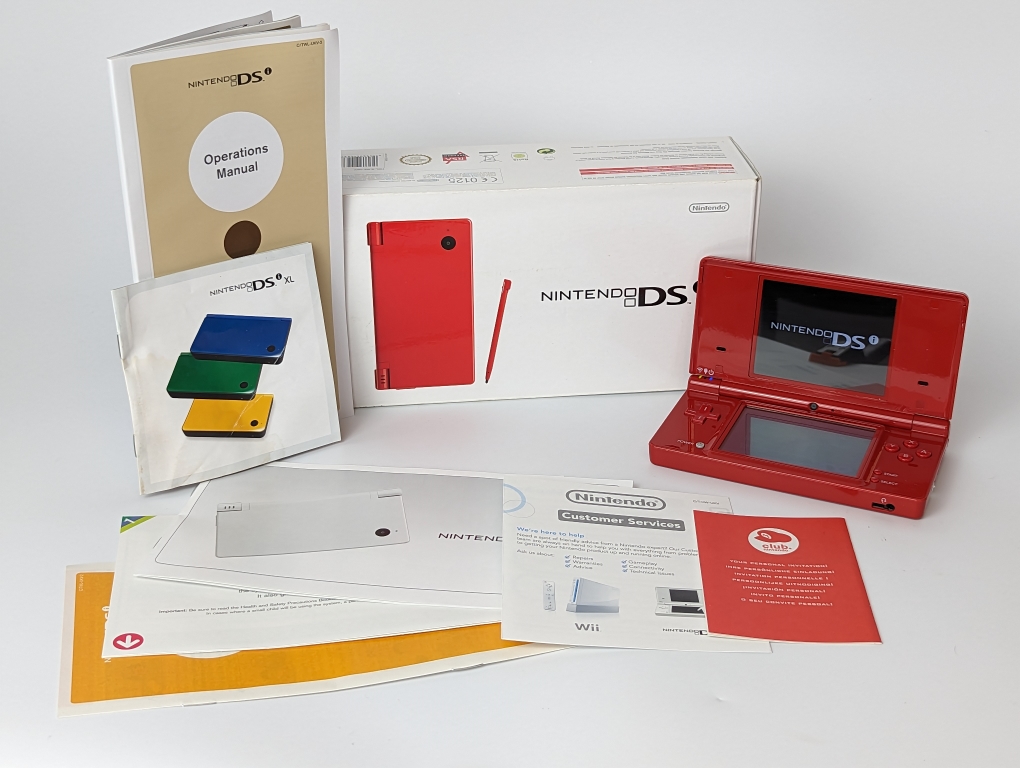The Nintendo DSi is a dual-screen handheld game console released by Nintendo. in 2008. It is the third model in the Nintendo DS family, and its primary market rival is Sony’s PlayStation Portable (PSP). The “i” in DSi symbolizes both an individual person (I) and the handheld’s cameras (eyes); the former meaning contrasts with the “i”‘s in Wii, which represent players gathering together.
The DSi has more RAM and a faster CPU than the DS Lite.
The camera’s resolution is two-and-a-half times higher than the handheld’s screens. However, their resolution is considerably lower than contemporaneous digital cameras and mobile phones. This was done to help keep their price reasonable and to maintain a preferable response time for viewing photos in quick session, particularity since numerous applications will use them.
Like the Wii, the DSi has upgradeable firmware, and features a menu interface that displays applications as selectable icons.
The built-in sound player has voice recording and music playback functionality. Voice recordings can be edited with audio filters and manipulated through pitch and playback. Users may save and modify up to 18 ten-second sound clips.
The Nintendo DSi connects to the Internet via either its built-in 802.11b/g Wi-Fi or a Nintendo Wi-Fi USB Connector; both methods grant access to the Nintendo Wi-Fi Connection service. Like the Wii, the DSi could connect to an online store. The store, called the DSi Shop, allowed users to download DSiWare games and applications. The service launched with the DSi Browser, a free web browser developed by Opera Software and Nintendo.
All DS games are compatible with the DSi, except those that require the GBA slot. Because of its absence, the DSi is not backward compatible with GBA Game Paks or with accessories that require the GBA slot, such as the Nintendo DS Rumble Pak and the Guitar Hero: On Tour series guitar grip.
“DSi-enhanced” game cards contain DSi-exclusive features, but can still be used with earlier models; “DSi-exclusive” game cards cannot.
The Nintendo DSi’s design is similar to that of the second DS iteration, the Nintendo DS Lite. The DSi has two TFT-LCD screens, larger than those of previous models. The touch sensitive lower screen accepts input from the included stylus.
The handheld features four lettered buttons (X, Y, A, B), a directional pad, and Start, Select, and Power buttons. Two shoulder buttons, a game card slot, and a power cable input are placed under the console’s hinge. The included AC adapter is not compatible with any previous DS model.
Nintendo removed the Game Boy Advance (GBA) cartridge slot to improve portability without sacrificing durability.
Unlike previous models, the handheld has two VGA (0.3-megapixel) digital cameras. The first points toward the user; the second is on the outer casing and faces away from the user. The SD card slot is also new, set behind a cover on the right side. While the DS Lite used a switch, the DSi, like the original Nintendo DS, features a button to power on or off. The button has extra functions and unlike the original’s power button, it is located on the bottom-left side of the touchscreen. Brightness and volume controls are on the left side; five brightness settings are available. The headset port is on the bottom.
The DSi has a matte surface to hide fingerprints. It is available in numerous colours, but colour selection varies by region. Numerous special-edition models and bundles have been released, including those for Ace Attorney Investigations: Miles Edgeworth, Final Fantasy Crystal Chronicles: Echoes of Time, and the 2009 Black Friday shopping day.
Reviews of the Nintendo DSi were generally positive; its added functionality over the previous models caused many journalists to recommend it to those who had not purchased a previous DS model stating the DSi Shop to be the most important buying incentive for current DS owners.
Numerous critics were disappointed with the limited resolution of DSi’s cameras, the console’s lack of exclusive software and removal of the GBA cartridge slot.
The DSi helped maintain strong sales for Nintendo’s handheld product line. The DSi accounted for 40 percent of its product line’s 2009 United Kingdom sales and frequently topped weekly sales charts in Japan during its first year of availability. In the United States, the console’s initial three-month sales surpassed those of the DS, DS Lite, and Wii.
The DSi and DSi XL quietly ceased production worldwide without any announcement on September 30, 2014 ten days before the release of the New Nintendo 3DS and New Nintendo 3DS XL.
Please click photo for more info


